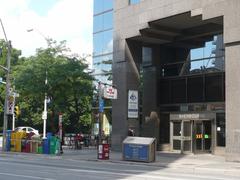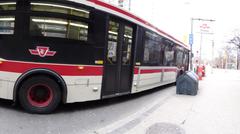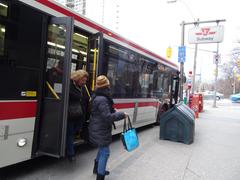
Sherbourne Toronto Visiting Hours, Tickets, and Historical Sites Guide
Date: 15/06/2025
Introduction to Sherbourne Toronto: History and Visitor Information
Sherbourne Street, one of Toronto’s oldest and most storied thoroughfares, is an essential destination for anyone seeking to experience the city’s layered history, diverse architecture, and dynamic cultural scene. Spanning from its late 18th-century origins as part of the Town of York grid—later renamed after Sherborne, England—Sherbourne Street has evolved into a vibrant urban corridor. Visitors can explore Victorian mansions, significant industrial landmarks, and innovative public spaces, all while engaging with a community that reflects Toronto’s multicultural spirit. This detailed guide covers Sherbourne’s key heritage sites—including the Colloden House, William Dineen House, The Selby, Our Lady of Lourdes Parish, and Sherbourne Common—alongside practical information on visiting hours, tickets, accessibility, transportation, and nearby attractions (Toronto Heritage Sites, blogTO, Trek Zone).
Contents
- Early Origins and Naming
- 19th Century Development
- Industrialization and Urban Change
- 20th Century Transformation
- Heritage Landmarks
- Colloden House
- William Dineen House
- The Selby
- Our Lady of Lourdes Parish
- Sherbourne Common
- Practical Visitor Information
- Visiting Hours
- Tickets and Tours
- Accessibility
- Transportation
- Nearby Attractions
- Modern Revitalization
- Cultural Significance and Community Life
- Visitor Tips
- FAQ
- Conclusion
Early Origins and Naming
Sherbourne Street traces its roots to the original Town of York grid in the late 18th and early 19th centuries. Originally called Caroline Street, it was renamed Sherbourne in 1845 by Samuel Smith Ridout in homage to his family’s ancestral town in Dorset, England. This foundational history marks Sherbourne as a cornerstone among Toronto’s historical sites.
19th Century Development
By the mid-19th century, Sherbourne was a prestigious boulevard, home to grand Victorian residences such as Colloden House (291-295 Sherbourne Street), which belonged to the J. Ross Robertson family. At Sherbourne and Bloor, a defensive blockhouse was constructed in 1838 after the Upper Canada Rebellion, highlighting the area’s strategic significance in Toronto’s early development.
Industrialization and Urban Change
Sherbourne’s southern end became an industrial hub in the late 19th and early 20th centuries, with Polson Iron Works operating until 1919. The introduction of public transit—horse-drawn streetcars in 1874, electrified by 1891, and later, the 75 Sherbourne bus—shaped the street’s growth and accessibility.
20th Century Transformation
Socioeconomic shifts in the 20th century saw many grand homes converted into rooming houses, particularly around Dundas and Sherbourne. This area became known for transitional housing, including Canada’s largest men’s hostel. Urban renewal projects in the 1960s and 1970s introduced modern residential towers and integrated public housing like the Sherbourne Lanes project. The block from 241 to 285 Sherbourne is noted for its historic and architectural significance.
Heritage Landmarks and Notable Sites
Colloden House
A designated heritage property at 291-295 Sherbourne Street, Colloden House stands as a rare Victorian-era residence.
William Dineen House
Located at 230 Sherbourne Street, the William Dineen House is a striking example of Victorian Italianate architecture, built in 1872 and protected under the Ontario Heritage Act (Toronto Heritage Sites). It forms part of the Garden District Heritage Conservation District, contributing to the unique character of the neighbourhood.
Visiting Hours:
Tuesday to Sunday: 10:00 AM – 5:00 PM
Closed Mondays and public holidays
Tickets:
Adults: $10; Seniors: $7; Students: $5; Children under 12: Free
Tickets available online or at the entrance.
Accessibility:
Wheelchair access and accessible restrooms available. Notify staff in advance for additional assistance.
Guided Tours:
Daily at 11:00 AM, 1:00 PM, and 3:00 PM.
Nearby Attractions:
Allan Gardens Conservatory, St. Michael’s Cathedral Basilica, and the Cabbagetown neighbourhood.
The Selby
At 592 Sherbourne Street, The Selby is an iconic Victorian mansion built for Henry Falwell Gooderham in 1882-83 and designed by David Roberts Jr. Its Queen Anne Revival style and storied history—as a private residence, school, hotel, and LGBTQ2+ community hub—make it a must-see (blogTO). The mansion is now home to Maison Selby restaurant.
Maison Selby Restaurant Hours:
Tuesday to Sunday: 11:30 AM – 10:00 PM
Sous Sol Bar: Wednesday to Saturday, 5:00 PM – midnight
Tickets:
No tickets required; reservations recommended.
Accessibility:
Wheelchair accessible via the modern tower addition.
Unique Features:
Restored period details, preserved fireplaces, and historic ambiance.
Our Lady of Lourdes Parish
At 520 Sherbourne Street, this parish is a focal point for community events and multicultural celebrations, including the annual Black History Month/African Heritage Mass.
Sherbourne Common
A contemporary waterfront park, Sherbourne Common symbolizes Toronto’s focus on sustainable urban development. Open since 2010, it features the Rainbow Fountain, modern playgrounds, and extensive green spaces (Trek Zone).
Visiting Hours:
Daily, 6:00 AM – 11:00 PM
Tickets:
Free entry; some special events may require registration.
Accessibility:
Fully wheelchair accessible, with accessible restrooms and paths.
Practical Visitor Information
-
Transportation:
Sherbourne is well-served by the TTC, including the 75 Sherbourne bus, Sherbourne subway station (Line 2), and nearby streetcar routes. Dedicated bike lanes and pedestrian-friendly streets make walking and cycling easy. -
Nearby Attractions:
St. Lawrence Market, Distillery District, Allan Gardens, Sugar Beach, and the Redpath Sugar Museum are all within walking distance. -
Parking:
Street and lot parking are available but limited; public transit is recommended.
Modern Revitalization
Sherbourne has seen significant revitalization since the 1960s, with restoration of heritage buildings, new residential towers, and the introduction of Toronto’s first dedicated bike lanes. Community-driven urban renewal and the addition of parks like Sherbourne Common have enhanced livability and accessibility.
Cultural Significance and Community Life
Sherbourne traverses diverse neighbourhoods, from Rosedale’s mansions to St. James Town’s high-density towers. Community events, activism, and multicultural festivals—many centered around Our Lady of Lourdes Parish and Sherbourne Health—reflect the area’s inclusive and vibrant spirit.
Visitor Tips
- Guided Tours:
Join local walking tours for deeper historical insights. - Transit:
Use the 75 Sherbourne bus or subway for convenient access. - Safety:
Exercise general city awareness, especially after dark in certain areas. - Cycling:
Take advantage of dedicated bike lanes. - Events:
Check parish and city websites for festivals and special events. - Parks:
Visit Sherbourne Common and Allan Gardens for green spaces and family-friendly activities.
Frequently Asked Questions (FAQ)
Q: What are the main visiting hours for Sherbourne Street landmarks?
A: Most sites are visible year-round; specific sites like the William Dineen House and Sherbourne Common have posted hours.
Q: Are tickets required for heritage sites?
A: Entry to most public spaces is free. Some heritage buildings and guided tours require tickets.
Q: Is the area accessible for people with mobility challenges?
A: Yes, major sites and parks are wheelchair accessible.
Q: How can I best reach Sherbourne by public transit?
A: Via Sherbourne subway station (Line 2) or the 75 Sherbourne bus.
Q: Are there good dining options?
A: Yes, Maison Selby, as well as numerous cafés and international restaurants along Bloor and Church-Wellesley Village.
Conclusion
Sherbourne Street offers a unique journey through Toronto’s architectural grandeur, historical evolution, and multicultural community life. Whether you’re exploring Victorian mansions, enjoying modern parks, or attending vibrant festivals, this area encapsulates the city’s heritage and contemporary dynamism. Plan your visit with the Audiala app, take advantage of public tours, and immerse yourself in one of Toronto’s most authentic neighbourhoods.
Call to Action:
Enhance your Sherbourne experience by downloading the Audiala app for guided audio tours, live event updates, and insider tips. Explore more about Toronto’s historical sites and stay connected via our website and social channels.


































































































































































































